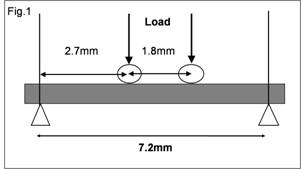ABSTRACT: 0859
Mechanical properties of novel self-etch resin based endodontic sealer
| K. SAEKI1, S. ZARTOSHTIMANESH2, M. STANINEC3, L.G. WATANABE2, S.J. MARSHALL4, and G.W. MARSHALL1, 1University of California, San Francisco, USA, 2University of California - San Francisco, USA, 3UCSF School of Dentistry, San Francisco, CA, USA, 4University of California San Francisco, USA | ||||||||||||||||||||||||||||
Objectives: The development of new adhesive endodontic materials may provide improved mechanical properties while providing strong apical and coronal sealing. In this study, we evaluated mechanical properties of a newly developed self-etch endodontic sealer, and compared its properties over time to a traditional root canal sealer based on the Grossman formula.
Materials and Methods: Flexural strength and flexural modulus of MetaSEALTM(MS) Parkell, NY, and U/P Grossman formula root canal sealer, Sultan(U/P), were evaluated by 4 point bending test. Beams (0.85x0.85x10mm), N =7 to 11,were prepared in microscope slides glass lined with mylar and were stored at 37°C in an incubator,(100% humidity) for 3,7,30 and 180 days. 4 point bending test was performed with ELectroForceTM3200(Bose, MN) at displacement rate: 1mm/min until fracture, load was placed as shown in Fig.1. Results: There was an increase in both flexural strength and modulus during aging for MS (R2=0.53, R2=0.80). MS at day 3, U/P at day 3 or 7 were too soft to be evaluated by this method. The flexural strength and modulus values for MS were much closer to those reported for dentin (187-200MPa, 12GPa, respectively, Takahashi et al.) than those for U/P.
*:p<0.001 Conclusions: The newly developed self-etching resin endodontic sealer had much higher flexural strength and modulus than U/P and gave values that were closer to that of dentin, which may help distribute stresses between root dentin and root canal filling material and lead to longer endodontic success. Supported by a grant from Sun Medical Co, Moriyama, Japan, A106545 | ||||||||||||||||||||||||||||
| Seq #127 - Physical Properties of Resin Composites and Glass Ionomers 2:45 PM-3:45 PM, Friday, April 4, 2008 Hilton Anatole Hotel Trinity I - Exhibit Hall | ||||||||||||||||||||||||||||
©Copyright 2008 American Association for Dental Research. All Rights Reserved.
